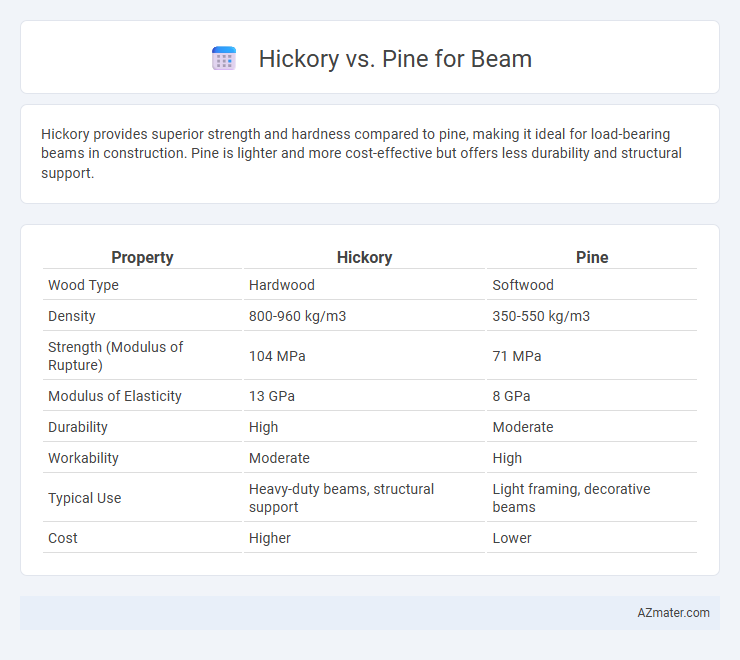Hickory provides superior strength and hardness compared to pine, making it ideal for load-bearing beams in construction. Pine is lighter and more cost-effective but offers less durability and structural support.
Table of Comparison
| Property | Hickory | Pine |
|---|---|---|
| Wood Type | Hardwood | Softwood |
| Density | 800-960 kg/m3 | 350-550 kg/m3 |
| Strength (Modulus of Rupture) | 104 MPa | 71 MPa |
| Modulus of Elasticity | 13 GPa | 8 GPa |
| Durability | High | Moderate |
| Workability | Moderate | High |
| Typical Use | Heavy-duty beams, structural support | Light framing, decorative beams |
| Cost | Higher | Lower |
Introduction to Hickory and Pine Beams
Hickory beams are highly valued for their exceptional hardness, strength, and shock resistance, making them ideal for structural applications requiring durability. Pine beams, characterized by their lighter weight and cost-effectiveness, offer good workability and are commonly used in residential construction and interior framing. Both woods vary significantly in density and grain patterns, influencing their performance and aesthetic appeal in beam construction.
Physical Characteristics of Hickory and Pine
Hickory beams exhibit exceptional hardness and density, with a Janka hardness rating of around 1,820 lbf, making them highly resistant to wear and impact. Pine beams, typically softer with a Janka rating between 380-870 lbf depending on the species, are lighter and easier to work with but offer less durability. Hickory's tight grain structure provides superior strength and shock resistance, whereas pine features a more open grain, contributing to its flexibility but reduced load-bearing capacity.
Strength and Durability Comparison
Hickory beams exhibit superior strength compared to pine, with a higher Janka hardness rating of approximately 1,820 lbf versus pine's range between 380-870 lbf, making hickory ideal for heavy load-bearing structures. Durability-wise, hickory also outperforms pine due to its dense grain and resistance to wear, sustaining less damage from impact and environmental factors. Pine, while lighter and easier to work with, tends to be more susceptible to dents, scratches, and decay, requiring more protective treatment for long-term applications.
Weight and Density Differences
Hickory beams are significantly denser and heavier than pine beams, making them ideal for structural applications requiring high strength and durability. The density of hickory ranges from 800 to 900 kg/m3, while pine typically falls between 350 to 550 kg/m3, affecting the overall weight and load-bearing capacity of the beam. Choosing hickory over pine results in a heavier beam, which translates to enhanced resistance to bending and impact, but may require more robust fastening and support systems.
Workability and Ease of Installation
Hickory beams offer exceptional workability due to their dense, hard grain, which requires sharp tools and careful handling but results in durable, wear-resistant structures. Pine beams are easier to cut, shape, and fasten because of their softer, lighter wood, making installation faster and less labor-intensive, particularly for framing and lightweight construction. Choosing between Hickory and Pine depends on the balance between the need for strength and the desire for quicker, more straightforward installation processes.
Aesthetic Qualities and Grain Patterns
Hickory beams exhibit a rich, varied aesthetic with pronounced, swirling grain patterns and a natural color range from pale amber to deep brown, lending a rustic yet sophisticated appearance ideal for statement beams. Pine beams feature a lighter, more uniform color palette with straight, subtle grain patterns that contribute to a clean, classic look suitable for both traditional and contemporary interiors. The contrasting grain intricacy of hickory provides visual texture and character, while pine's smoother grains offer a softer, understated elegance in architectural beam applications.
Cost Considerations: Hickory vs Pine
Hickory beams generally cost more than pine due to their superior density, durability, and hardness, making them a premium choice for heavy-load applications. Pine, being a softer and more abundant wood, offers a more budget-friendly option with easier workability but may require more maintenance and faster replacement over time. When evaluating cost considerations, factoring in Hickory's longer lifespan and resistance to wear often justifies the higher upfront investment compared to the economical but less durable pine.
Resistance to Decay and Insects
Hickory wood exhibits superior resistance to decay and insects compared to pine, making it a more durable choice for structural beams in environments prone to moisture and pest exposure. Pine, being softer and less dense, is more susceptible to fungal decay and insect infestation unless properly treated with preservatives. For long-lasting beams, hickory's natural toughness and resilience provide enhanced protection against biological deterioration.
Environmental Impact and Sustainability
Hickory beams offer superior durability and longevity, reducing the frequency of replacement and minimizing resource consumption over time compared to pine. Pine, being faster-growing and more widely available, typically has a lower initial environmental impact due to its rapid renewability and carbon sequestration rate. Both woods can be sustainably sourced, but hickory's slower growth requires careful forest management to ensure ecological balance and reduce habitat disruption.
Best Applications for Hickory and Pine Beams
Hickory beams excel in applications requiring superior strength and durability, such as structural supports in residential and commercial construction, heavy timber framing, and outdoor projects exposed to harsh weather conditions. Pine beams are best suited for interior framing, decorative elements, and lightweight construction where ease of handling and cost-effectiveness are priorities. Both woods offer distinct advantages, with hickory providing greater load-bearing capacity and pine offering versatility and affordability.

Infographic: Hickory vs Pine for Beam
 azmater.com
azmater.com